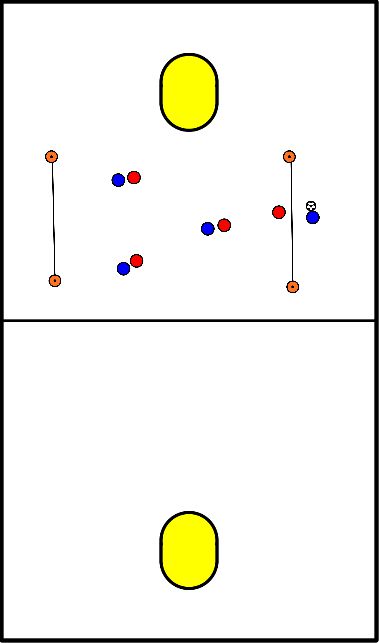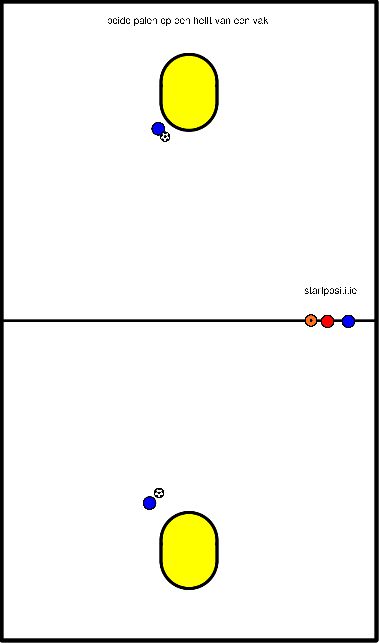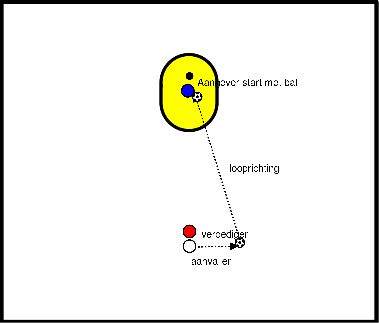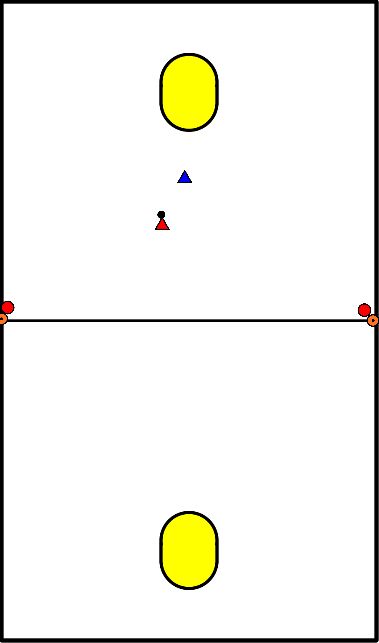Korfball drills for technique defense
Objective:
- Earn a point by catching the ball over the line.
Rules:
- A party starts from behind the line with the ball.
- Intercepted ball is ball first to your own line and then to the other side for a point.
- Balls out count.
- When a point is gained, the opponent gets the ball from there.
Points of attention:
- For defending.
- Play on the side by moving on one leg.
- Play at tempo.
- Watch each other and your opponents place.

Task:
- Attack:
- Try to score as much as possible on baskets.
- Defense:
- Try to prevent as many scoring opportunities as possible without getting sidelined.
Rules:
- Attack:
- After each goal attempt, return to the starting pawn.
- It is not allowed to shoot defensively.
- Defence:
- If you cause a penalty throw (indicated by the declarer), you get one point in your rounds as attacker.

- The ball starts under the basket and is thrown to the child in front of the basket.
- The child under the basket then runs after the ball to defend.
- It is important that the attacker is central. With too much defensive pressure, the attacker cannot practice.
- Keep moving and make sure the pass comes from the space.
- There is always room for a break-through or a shot.
- The third player takes care of the catch and plays the ball again.
- Make sure you are always on the move and keep space for your teammates
- There is always one of the 4 (diagonal to the ball) who sinks to the post to be able to catch a shot
- Try to get each other in a shooting position at a maximum of 6 metres, or indicate from the space that you want to break through because the opponent is biting.
- In the 1:1 you try to score 2x in 1 minute.
- The defender makes choices which ball she defends.
- The attacker and the passer play this out together.
- attack, defend and pass each 3x 1 minute.
- You have 2 teams and you have to play together to get the ball into the opponent's box.
- Your opponents can cover you but they can also intercept
- If this happens, the other team may attack and try to get the ball into the other team's box
- You need a 3 or 4 team to defend the run through.
- One person under the basket with the ball and possibly also a catcher.
- In front of the basket, an attacker and a defender, at about 5-6 meters from the basket (at far shot distance).
- The person under the basket (attacker) has the ball.
- The attacker runs sideways (right or left) and gets the ball from the person in charge.
- The attacker throws the ball back to the attacker and goes in a straight line to the basket and makes a run through or in out shot (if the run through is too well defended).
- The defender stays in the right place to prevent the run through.
- Point of attention defense:
- Stay close to the attacker
- Keep your knees bent
- Do not turn around when the ball is thrown
- Do not run after your opponent

- You have two attackers on the side in the middle between two baskets.
- The attacker must try to score with the help of the two players.
- At an interception, the defender becomes the attacker.
- When a goal is scored, the attacker gets a bonus and is allowed to keep attacking, only now he has to attack the other basket.
- When three goals have been scored, the winning attacker is rested and exchanged with a declarer.

In short: practicing various shooting variants in a fun competition form.
- Organization: per group a basket and a ball, the baskets are preferably (but not necessary) arranged in a circle or rectangle.
- The number of persons per group is less important (but all groups are about the same size).
- The first assignment for the groups is: score 10 goals.
- When you have completed this assignment, the person who scored the last goal runs to the trainer to pick up the next assignment.
- Which group completed all assignments first?
- The trainer walks around, encouraging, or correcting.
- He has a piece of paper with him with a row of assignments on it.
- When someone comes to pick up the next assignment, first ask which one has just been done (this can vary considerably over time) and then hand out the next assignment.
- An example list: 10 walk-through balls, 15 penalty shots, 5 8-meter shots, 10 walk-through balls from behind the basket, 5 dodge balls next to the pole, 10 6-meter shots.
- Everything is possible of course, a lot of momentum is gained if the number of goals to be scored is kept small.
- 10 walk-through balls
- 20 small oppertunities
- 6 remote shots
- 10 penalty throws
- 1 backwards
- 4 against 4.
- Pay attention to the basic set-up, to the ball pace and to the movement of the players, so that there is not just one attacker moving.
- Make the game more surprising by moving the ball, pulling the ball away, throwing it deep, etc.
- 3 attackers against 2 defenders.
- Attack within a radius of about five metres around the basket.
- All attackers may shoot.
- The defenders must try to score as few goals as possible.
- 5 x 1 minute. After each minute turn around.
- If the number is right, you can specifically train zone defence during the game: Zone defending.
- The defenders let go of their opponents as soon as they get further than about six metres from the post.
- The defender then has only one task: intercepting the ball by grabbing the rebound.
- This also includes letting the attacker shoot from distance.
- After all, if they do not shoot, they cannot catch the ball.
- Instruct certain attackers to give more pressure than others.
- The art of collective backfield defending is to give the pure shooters so much pressure that they prefer to leave the shot to a teammate who is as free as a bird (but who is deliberately left free by the defence because it is known that he 'can't shoot anyway').








